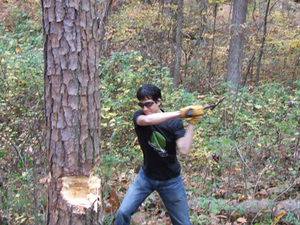If you are a tried and true traditionalist who enjoys chopping down a tree for Christmas, then congratulations! Not only do you get a real tree in your living room but you also get to enjoy a true cardio workout! Chopping down a tree may only be the means-to-an-end but it’s also a great muscle and stamina builder, and as true an aerobic exercise as ever was created.
This is not to say that you can go out into the forest (and probably on government land) and start whacking down trees. Trees are a protected natural resource. You can however, obtain permission (usually to go on those same government lands) and spend an hour or so on the tree of your choice. Before you charge out there like Paul Bunyan, take stock of what you’re dealing with. Because chopping down a tree presents a unique set of challenges.
Like any form of exercise, if you are going to be swinging an axe, you need to warm up first. The whole movement of chopping wood focuses on your shoulders, waists and back, not to mention your forearms.
Now let’s move on and discuss technique: there are many things to do and consider before starting to fall a tree. Check out the tree. Is it big enough to suit your needs? Take note of how it leans and how is it weighted? This has a lot to do with the direction it will fall.
Let me interject for a moment and assume you are not going to cut down a redwood. A typical size pine tree is more than enough challenge to cut and also get a good pump.
1) Start with a 45 degree notch on the side that the tree will fall towards. Cut the bottom of the notch first, about one third of the way through the diameter. The second cut is made at a 45 degree angle that will meet the depth of the first cut. The felling cut should be made from the opposite side, about 2 inches higher than the floor of the notch. Do not cut all the way through but leave a hinge that will keep the tree from kicking back and upward as it falls. The hinge will be about 1/8 to 1/6 of the diameter where you are cutting but it may vary depending on when the tree starts to fall.
2) Now comes the “real” work: limbing the tree. Be sure that the fallen tree is stable and will not move as you work. Examine the situation at every limb to be removed. Be certain that the limb will not bind as you cut with the axe. Cut on the opposite side of the tree trunk whenever possible, this keeps the trunk between you and the saw. Never stand on the downhill side when removing limbs. Always keep in mind that the tree trunk may roll as limbs are removed. Watch for limbs that may spring out when they are cut due to the released tension. These limbs can cause injury.
Now a few words about safety:
– Wear gloves to avoid blisters on your hands
– Always avoid making cuts with the saw between your legs, always cut with the saw to the outside of your legs.
– Always stand to one side of the limb you are to cut, never straddle it.
– Boots should ALWAYS be worn when using any axe.
– When using an axe a designated chopping area should be cordoned off. This should be in an area where there are few, if any, overhead branches. NEVER chop on the ground always use a chopping block, and aim at where the branch is supported by the block.
– The axe should always be masked when finished with or not in use. This can be done with a leather (or similar material) cover, or by being left in a log.
– When burying the axe-head, make sure that the axe handle is never overhanging the length of the log.
– When the axe has to be transported from one area to another, it should be masked (obviously not within a log) and should be carried so that the head is in your hand with the blade facing forwards and the toe facing towards the sky.
Chopping trees is a good workout if you treat it as an exercise and warm up accordingly. Happy holidays!




